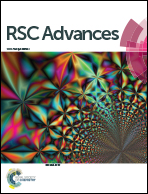Photosensitive self-assembling materials as functional dopants for organic photovoltaic cells
Abstract
New photosensitive liquid crystalline compounds with a specific molecular structure have been designed in order to use them as functional dopants for organic photovoltaic devices. The main idea is to establish the effect of doping on the bulk-heterojunction solar cell properties and characteristics. As a part of basic characterisation, the self-assembling behaviour of three new organic compounds has been determined. The resulting photovoltaic devices with a P3HT:PCBM active layer doped by the designed photosensitive materials were investigated by UV-Vis spectroscopy, electrochemical measurements, cyclic voltammetry experiments, AFM surface morphology studies and impedance spectroscopy. The obtained results are summarised and discussed in terms of power conversion efficiency improvement considering the specific chemical structure of the compounds used as functional dopants and the annealing temperature of an active layer. The molecular structure of compounds used as a dopant has a strong effect on the value of short circuit current density. However, no significant effect of the dopant in the P3HT:PCBM active layer on the open circuit voltage and fill factor has been found.


 Please wait while we load your content...
Please wait while we load your content...